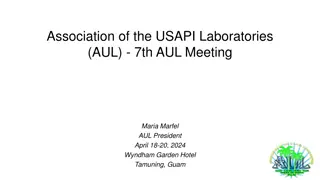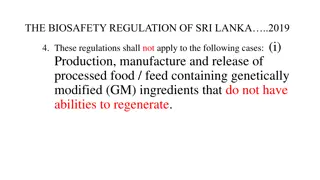Understanding Biosafety and Containment Measures in Laboratories
This content provides comprehensive information on biosafety, containment, biohazards, and the importance of preventing laboratory acquired infections. It covers the principles, practices, and procedures designed to safeguard against biological agents and toxins. The concept of biosecurity, containment levels, and safety measures are detailed to minimize human and environmental exposure to harmful pathogens. Additionally, it explains the significance of primary and secondary containment methods in laboratory settings.
Download Presentation

Please find below an Image/Link to download the presentation.
The content on the website is provided AS IS for your information and personal use only. It may not be sold, licensed, or shared on other websites without obtaining consent from the author. Download presentation by click this link. If you encounter any issues during the download, it is possible that the publisher has removed the file from their server.
E N D
Presentation Transcript
Objectives Biosafety overview Background Principles Containment Risk Assessment Blood borne Pathogens
What is Biosafety? The principles, practices, procedures, and containment measures designed to prevent the accidental exposure to or release of biological agents and toxins. What is Biosecurity? The protection, control, and accountability measures implemented to prevent the loss, theft, misuse, diversion or intentional release of biological agents and toxins.
What is a Biohazard? An agent or material of biological origin that has the capacity to produce deleterious effects in humans, animals, or the environment: Viruses, Bacteria, Fungi, Parasites, Prions
Why Biosafety? Laboratory Acquired Infections (LAIs)
Containment Primary goal of biosafety: reduce or eliminate human and environmental exposure to potentially harmful agents. Biological Containment Inactivating mutations Reducing virulence or pathogenicity Primary Containment Protects lab personnel and the immediate lab environment Biological Safety Cabinet (BSC) Good microbiological techniques (PPE, decontamination, etc.) Safety centrifuge cups. Secondary Containment Protects environment external to the lab Facility design and operations lab doors and/or anterooms specialized air handling systems for contamination control autoclaves hand washing, eyewash, shower stations.
What are Biosafety Levels (BSLs)? The primary risks that determine levels of containment are: Risk Group category Infectivity Severity of disease Transmissibility Nature of the work conducted
Biosafety Level 1 (BSL1) Risk Group 1 Agents: E.coli K-12 Transgenic plants Fungi Mold Yeast Lab Practice Standard microbiological practices Open bench work ok unless aerosols generated, then use BSC Daily decontamination Required hand-washing Autoclave waste Safety Equipment PPE gloves, lab coat, eye protection as needed BSC if generating aerosols Facility Sink available for hand washing Door on lab with appropriate signage
Biosafety Level 2 (BSL2) Builds on BSL1 requirements Risk Group 2 Agents: Human or primate cells Herpes Simplex Virus (HSV) Replication-incompetent attenuated HIV Patient specimens Staphylococcus aureus Lab Practice Access to the laboratory is restricted when work is being conducted PPE = lab coats, gloves, eye protection, face shields or masks as needed. Decontamination after each procedure Autoclave waste Document training
BSL2 cont. Safety Equipment Biosafety cabinet (BSC) Sharps containers Autoclave waste bags/containers Facility Self-closing doors with BSL2 signage Autoclave Sink and eyewash station readily available Label all equipment in contact with biohazard
Biosafety Level 3 (BSL3) Builds on BSL2 requirements Risk Group Agents: Respiratory transmission Mycobacterium tuberculosis HIV (wild-type) Coxiella burnetii Lab Practice Medical surveillance, baseline serology Immunizations available or required Autoclave all waste at end of day Avoid use of sharps No bench top all work in BSC PPE double gloves, PAPR, wrap around disposable gown
BSL3 cont. Safety Equipment All work with microbes must be performed within an appropriate BSC Facility A hands-free sink and eyewash Exhaust air cannot be recirculated Sustained directional airflow by drawing air into the lab from clean areas towards potentially contaminated areas Entrance to the lab is through two sets of self-closing and locking doors Access to the laboratory is restricted and controlled at all times.
Biosafety Level 4 (BSL4) Maximum containment facility - builds on BSL3 Requirements Risk Group Agents high risk of aerosol-transmitted infections exotic, frequently fatal examples: Ebola and Marburg viruses Lab Practice Change clothing before entering Shower upon exiting Decontaminate all materials before exiting Safety Equipment All work performed in Class III, wearing a full body, air-supplied, pressure suit. Facility separate building or restricted zone dedicated supply and exhaust air, and vacuum lines and decontamination systems positive
Biosafety Risk Assessment 1. Identify the hazard 2. Assess potential risk to personnel and/or environment: Identify Risk Group What is the scale of work volume, concentration What are the procedures/manipulations aerosol generating? Useof sharps? Determine pathogenicity is it wild-type or attenuated? What is the infectious dose? What is the route of entry? Are prophylaxis treatments available? Are personnel trained? Any risk to immuno-compromised or pregnant personnel? 3. Determine appropriate containment/biosafety level (BSL)
Classification of Infective Agents by Risk Group Risk Group 1 Risk Group 2 Risk Group 3 Risk Group 4 Severity of Disease unlikely to cause human or animal disease can cause disease, unlikely to be serious, effective treatment and preventive measures available can cause serious disease, does not ordinarily spread from one person to another, effective treatment and preventive measures usually available, exposure route: inhalation (often) likely to cause serious or lethal disease, can be readily transmitted from one individual to another, effective treatment and preventive measures are not usually available, transmission: direct, indirect, inhalation Host Range human (healthy adult) and animals human (healthy adult) and animals human (healthy adult) and animals human (healthy adult) and animals Individual Risk low moderate (potential hazard) high high Communit y Risk low low low high























